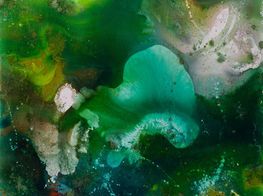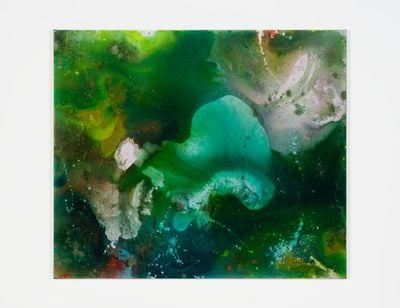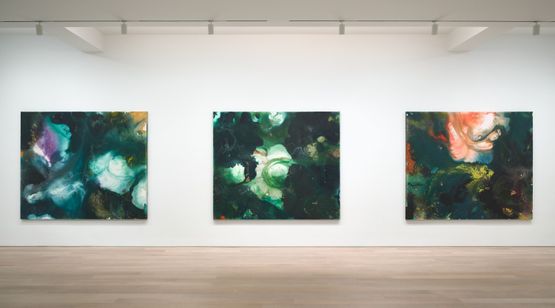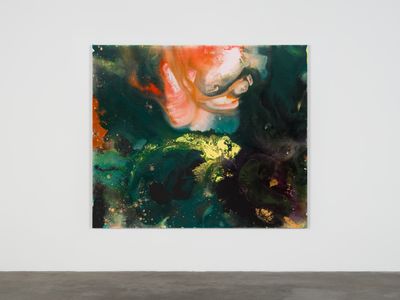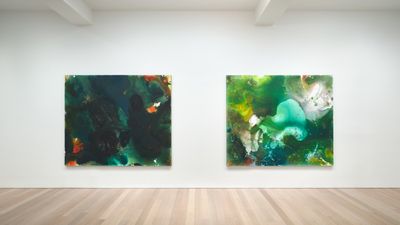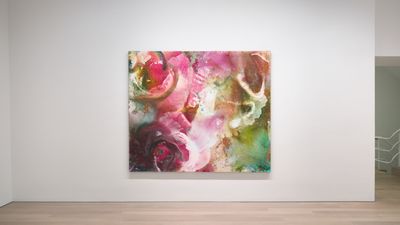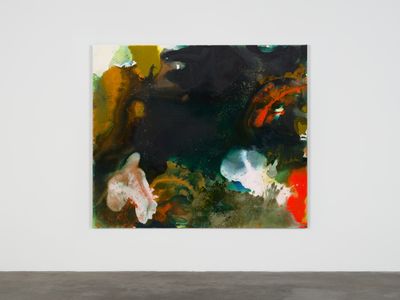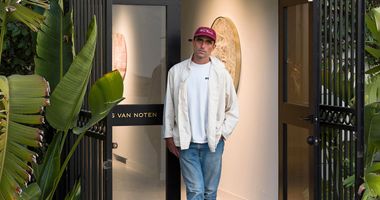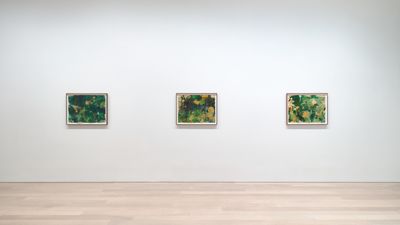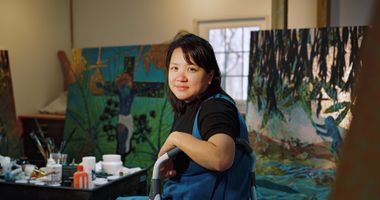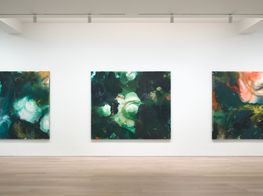In Free Fall: Mary Weatherford on Sea and Space
Mary Weatherford in her studio with The Flaying of Marsyas–3500 Spectra (2021–22). Courtesy Gagosian. Photo: Elena Dorfman.

Mary Weatherford in her studio with The Flaying of Marsyas–3500 Spectra (2021–22). Courtesy Gagosian. Photo: Elena Dorfman.
Freediving is an activity not for the faint-hearted, requiring surrender to the ocean. Blocking out the world, divers enter a meditative state to calm the mind and preserve oxygen.
During the descent there is a threshold at which Earth's gravitational pull becomes stronger than the diver's buoyancy. From this point gravity creates a freefalling experience to the sea floor.
In Mary Weatherford's large-scale, abstract canvases, diluted yet richly pigmented paint coalesces and repels with a force much like the gravity central to freediving. This gravitational threshold of opposing forces is also experienced in space exploration—an activity the L.A.-based artist has been interested in for many years, as evidenced in her collection of NASA photographs, and her patronage of the astrophysics lectures at the Rose Center for Earth and Space in New York City.
Weatherford's practice is informed by natural phenomena and diverse artistic influences, from Land art to Abstract Expressionism. Graduating with an MFA from Bard College in 2006, she assembled elements such as starfish, sponges, and seashells in her early paintings, which gave way to a language of dramatic painterly gesture reminiscent of the fabric swathes of Baroque painting.
In 2012, Weatherford began incorporating neon tubing into what became 'sculptural drawing' atop the canvas, developed during her time as a visiting artist at California State University at Bakersfield. Screwed into the canvas, these fine, glowing tubes with draped wires and magnetic transformers lend a technological edge to the natural colours of the California sunsets Weatherford has experienced on her evening drives.
A kind of otherworldly light illuminates her paintings from within—the result of a carefully prepared ground of white gesso mixed with marble dust. Working with vinyl-based Flashe paint, Weatherford pours and sponges swathes of colour across the canvas. Clusters of dense gestures are held in tension with areas of minimal paint, as the chalky surface absorbs the paint to a fresco-like effect.
Titled Sea and Space, Weatherford's new exhibition at Gagosian's Madison Avenue space simultaneously evokes the watery depths of aquatic environments and the endless reaches of space. Developing from earlier paintings, the gestures in her latest works are more subtle and appear submerged. Pale pink, mint, and moss greens, such as those in Celadon Anemone (2023), are poured onto wet, dark surfaces and bloom in coral-like shapes. Hues of misty acid-green are cast upon deep forest green which recedes into the picture plane.
Accompanying the larger paintings are smaller works on paper—not studies, but works in their own right. Surface-rich and evocative of dappled forest light, these are a recent development in Weatherford's practice, created whilst in residence at the Elaine de Kooning House in East Hampton in the summer of 2023. I spoke to Weatherford as she prepared for the opening of Sea and Space.
GWCould you speak broadly about the concept of Sea and Space?
MWThe concept was simple: green. The paintings are 79 inches tall by 93 inches wide. I have worked with that format before, but vertically. Turned on their side, I thought that size would be ideal for the Madison Avenue space with the beautiful skylights.
Why green? I had seen that colour green underwater in Kauai. I was staying near a place where, while snorkelling (what a strange word!), I saw sea turtles often. Sometimes I would hold my breath and try to follow them just wearing goggles. I liked swimming near them and waiting until they came up for breath. Their beautiful faces would come above the water with those beautiful eyes and the ancient beak. It was a beautiful thing.
I was in Berlin for an exhibition last summer. I had made a series of green paintings some years ago that I was exhibiting in Berlin. I saw them again there, the deep green of the forest. In the mornings I would walk in the Tiergarden, which is green, green, green, many shades of green. This idea of green settled into my mind.
I read a book about freediving, and watched videos of freedivers playing around with gravity on the sea floor. I attended a poetry workshop in Oahu, and there met Kimi Werner, a famous freediver. I asked her what it felt like. She said, at the beginning of the dive, buoyancy pulls at her. Further down, she enters a zone of no gravity and no buoyancy, a neutral zone. Further down, gravity begins to work. Coming back up, it's the opposite. First against gravity, then the neutral zone, and beyond that buoyancy. I asked her what it was like to be so deep with the pressure of the ocean, and she said, it's like the greatest hug you've ever had. Wow. I was really terrified.
The push and pull of gravitational force is imitated in paint.
I have been thinking about the way things move underwater. It shows up in these new paintings in terms of—I don't want to call them beings—but shapes, phenomena. They're not really objects, but things that are moving and transforming in an environment in which gravitational pull is absent.
GWIt's interesting to think about this idea of gravity and being underwater in relation to gesture. In your earlier works, the hand is more present in the gesture, but with this exhibition it feels like the gestures have almost submerged under the surface. I was curious to know about your use of gesture and how it has changed over time.
MWI always painted on the floor or table, then I built a wooden platform in my studio. I'm able to level it by adjusting the feet. That means that if I pour a bucket of water on the painting, the puddle will stay where it is. I don't know if you've done this, most people have, it's a childhood thing, if you see a water puddle, maybe with some dirt in it, you can draw in it with a finger. I learned to do that with the paint. I could put paint down, flood the canvas with water, and then draw into it with a sponge, which would be an erasure, but not quite an erasure because the water flows back in.
GWCould you talk more about your interest in outer space? Why paint about space at this moment in time?
MWI have a collection of photos of outer space. I've been collecting these images for maybe 30 years, or more. It started with a box of 35 millimetre slides from the Reuben H. Fleet Science Center in San Diego. Then I purchased more slides from museums. Once the internet arrived and NASA put their images online, I downloaded a lot.
One of my favourite things to do when I lived in New York City was attend the lecture series organised by Neil deGrasse Tyson at the Rose Center for Earth and Space attached to the Natural History Museum. I happened to be painting one day, and I heard Michio Kaku come on the radio and talk about time and space. It got my attention, and I went to see him talk. He's a superstar. He is an expert in string theory, and it was packed. Tyson said if you like this lecture come back next month. I became a patron of these lectures on astrophysics. Usually there wasn't a big audience. It was me, teenage boys and the fathers of the teenage boys.
I did that for a few years, and a lot of those ideas have stuck with me. One of the most compelling lectures was: what is the cheapest way to get to the moon? And I'll tell you; the problem is that rocket fuel weighs a lot. Where you're going to spend it is slowing down, landing on the moon, and taking off from the moon. This was a lecture about the concept of fuzzy boundaries, which again goes back to the freediving. There's a place between the earth and the moon where the gravitational pulls touch and become neutral. Therefore, a rocket would not be pulled towards the earth nor towards the moon.
I was interested in dismantling the paintings and rebuilding them. That's when I started down the path I'm on, painting from life, which then led me back into abstraction.
So again, there's that place that the freediver talked to me about where one thing shifts into another. When I'm painting, I'm working with the differences in the weight of the paint. If I take some paint with a high viscosity and I pour it into say, a puddle of paint with a low viscosity, the thick paint will spread out at first, and then it'll pull the thin paint back over it like a veil. The push and pull of gravitational force is imitated in paint.
GWGravity is literally playing out in the movement of the paint. But I'm also curious about the fact you paint on the floor, because here I was thinking how the paintings have their own gravity. When you paint on the floor and you bring it up onto the wall, it hangs with a weight that might not have been there.
MWAt Bard, when I was in my late thirties and where I got my MFA, I built things on the floor. I made three dimensional paintings out of plaster and chicken wire that resembled what I'm making now. I've always painted horizontally. There's never been a time when I haven't.
I was interested in dismantling the paintings and rebuilding them. That's when I started down the path I'm on, painting from life, which then led me back into abstraction. When I arrived at Bard, the first thing I did was place a piece of plexiglass down on the ground and trace what I saw. Often, I was tracing weeds. Then I would bring the plexiglass back to the studio and put pieces of paper on top to make drawings of the ground. This was my first drawing from life, not really drawing from observation, but almost tracing life.
GWYou once said that you enter a small painting with your mind and not your body. How do the works on paper in this exhibition operate?
MWIt's a different process. I work on more than one at a time like the paintings. These are made on a Gampi paper that I commissioned in Japan. The ink is a German shellac ink, and this time I added my own mixtures made with powdered pigments. I used metallic gold, a reference to [Gustav] Klimt. I wanted to reproduce the phenomenon of summertime dappled light.
The paper works are not as 'enterable' as the paintings. They are more physical and crustier. You look at the surface of these drawings.
GWThe title of the exhibition Sea and Space makes me think of the idea, as above so below. What about the titles of individual paintings, how do they come about and add to the work?
MWIf there's a shovel hanging on the wall, and the title is In Advance of the Broken Arm, that changes the object. I don't want the title to change the painting that much. One picture got its title immediately because it looks like a cyclops or an eyeball. It's called The Emersonian. In Emerson's essay 'Nature' there is a famous passage, which says, 'I become a transparent eyeball'.
GWThe architect Gaudí once said the light of the Mediterranean produced great art because light strikes objects at a 45-degree angle there. In a similar way, Los Angeles is known for its incredible light. Can you talk specifically about how you have responded to light in your work?
MWI am interested in the light in different places. Light in New York City is beautiful. I made a very touristic eight-day trip to Oaxaca. I have never seen light like that. Oaxaca is in a valley, surrounded by high mountains. It was spectacular, and has nothing to do with a nearby ocean.
GWDo any of the works in Sea and Space include the neon light?
MWNo, none of the paintings have neon. They have their own light. —[O]

